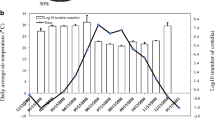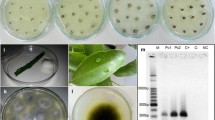Abstract
Infection of non-wounded and freshly wounded detached plum fruit by airborne Monilinia laxa conidia on dry, humid and wet plum fruit surfaces, and by conidia and germlings that had been established on fruits under these wetness regimes, was investigated. Plum fruit (cv. Laetitia) were dusted with dry conidia in a settling tower at pit hardening, 2 weeks before harvest, at harvest and after 28 days cold storage. Non-wounded immature and mature fruit remained mostly asymptomatic, whereas non-wounded cold-stored fruit decayed readily. Wounding drastically increased infection by airborne conidia. Immature fruitswere less susceptible to wound infection by airborne conidia than mature fruits. Conidia that were dispersed freshly were more successful in infecting fresh wounds than conidia that were deposited, or germlings that established, on fruits 4 days prior to wounding. This decrease in infectivity was especially pronounced on humid-incubated fruit and on wet-incubated fruit. This study clearly showed that in order to reduce the incidence of brown rot, inoculum levels on fruit approaching maturity should be reduced by sanitary practices and fungicides. Furthermore, it is essential to protect fruit, especially near-mature fruit, from being wounded.
Similar content being viewed by others
References
Bostock RM, Wilcox SM, Wang G, Adaskaveg JE (1999) Suppression of Monilinia fructicola cutinase production by peach fruit surface phenolic acids. Physiological and Molecular Plant Pathology 54, 37–50. doi: 10.1006/pmpp.1998.0189
Byrde RJW, Willetts HJ (1977) ‘The brown rot fungi of fruit: their biology and control.’ 1st edn. (Pergamon Press Ltd: Oxford)
Cruickshank RH, Wade GC (1992b) Production of appressoria by Monilinia fructicola. Mycological Research 96, 425–428. Curtis KM (1928) The morphological aspect of resistance to brown rot in stone fruit. Annals of Botany 42, 39–68.
Fourie JF, Holz G (1985a) Postharvest fungal decay of stone fruit in the South-Western Cape. Phytophylactica 17, 175–177.
Fourie JF, Holz G (1985b) Artificial inoculation of stone fruit with Botrytis cinerea, Monilinia laxa and Rhizopus stolonifer Phytophylactica 17, 179–181.
Fourie JF, Holz G (1987) Infection and decay of stone fruit by Botrytis cinerea and Monilinia laxa at different stages after anthesis. Phytophylactica 19, 45–46.
Fourie JF, Holz G (1992) Effect of free moisture on the development of post-harvest decay. In ‘Proceedings of the Conference on Refrigeration in the Production, Storage and Distribution of Perishable Products’. pp. F2.1-F2.10.
Fourie JF, Holz G (1998) Effects of fruit and pollen exudates on growth of Botrytis cinerea and infection of plum and nectarine fruit. Plant Disease 82, 165–170.
Fourie PH, Holz G (2003a) Germination of dry, airborne conidia of Monilinia laxa and disease expression on nectarine fruit. Australasian Plant Pathology 32, 9–18. doi: 10.1071/AP02063
Fourie PH, Holz G (2003b) Germination of dry, airborne conidia of Monilinia laxa and disease expression on plum fruit. Australasian Plant Pathology 32, 19–25. doi: 10.1071/AP02066
Fourie PH, Holz G, Calitz FJ (2002) Occurrence of Botrytis cinerea and Monilinia laxa on nectarine and plum in Western Cape orchards, South Africa. Australasian Plant Pathology 31, 197–204. doi: 10.1071/AP02007
Hall R (1971) Pathogenicity of Monilinia fructicola Part II. Penetration of peach leaf and fruit. Phytopathologische Zeitschrift 72, 281–290.
Jerome SMR (1958) Brown rot of stone fruits. Latent contamination in relation to spread of the disease. The Journal of the Australian Institute of Agricultural Science 24, 132–140.
Kable PF (1971) Significance of short-term latent infections in the control of brown rot in peach fruits. Phytopathologische Zeitschrift 70, 173–176.
Naqvi SHZ, Good HM (1957) Studies of the aging of conidia of Monilinia fructicola (Wint.) Honey. I. Germination rates and longevity. Canadian Journal of Botany 35, 635–645.
Schlagbauer HE, Holz G (1987) Blossom blight and brown rot of stone fruit caused by Monilinia laxa in the Cape Province of South Africa. Phytophylactica 19, 513–514.
Schlagbauer HE, Holz G (1989a) Occurrence of latent Monilinia laxa infections on plums, peaches and apricots. Phytophylactica 21, 35–38.
Schlagbauer HE, Holz G (1989b) Penetration of plums by Monilinia laxa and histology of a defense reaction. Phytophylactica 21, 39–43.
Smith MA (1936) Infection studies with Sclerotinia fructicola on brushed and non-brushed peaches. Phytopathology 26, 1056–1060.
Snedecor GW, Cochran WG (1980) ‘Statistical methods.’ 7th edn. (Iowa State University Press: Ames)
Wade GC, Cruickshank RH (1992) Rapid development of resistance of wounds on immature apricot fruit to infection with Monilinia fructicola. Journal of Phytopathology 136, 89–94.
Willetts HJ, Bullock S (1993) Cytology, histology, and histochemistry of fruit infection by Monilinia species. In ‘Handbook of cytology, histology, and histochemistry of fruit tree diseases’. (Ed. AR Biggs) pp. 113–136. (CRC Press, Inc.: Boca Raton)
Xu X-M, Robinson JD (2000) Epidemiology of brown rot (Monilinia fructigena) on apple: infection of fruits by conidia. Plant Pathology 49, 201–206. doi: 10.1046/j.1365-3059.2000.00437.x
Author information
Authors and Affiliations
Corresponding author
Rights and permissions
About this article
Cite this article
Fourie, P.H., Holz, G. Wound infection of plum fruit by airborne conidia of Monilinia laxa . Australasian Plant Pathology 35, 435–439 (2006). https://doi.org/10.1071/AP06042
Received:
Accepted:
Issue Date:
DOI: https://doi.org/10.1071/AP06042




